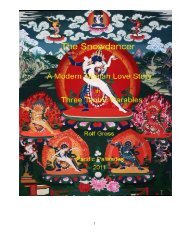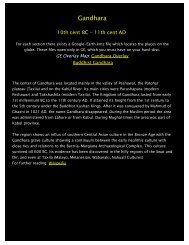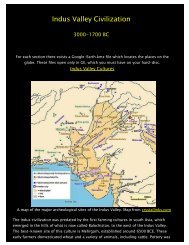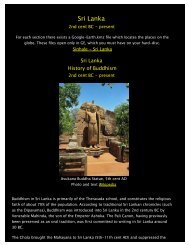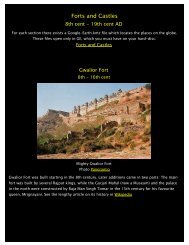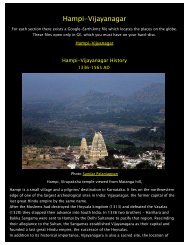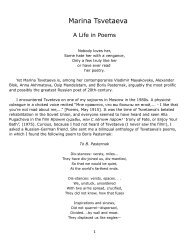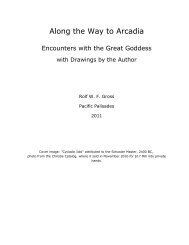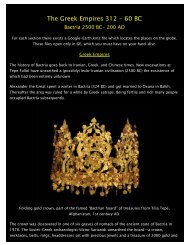Create successful ePaper yourself
Turn your PDF publications into a flip-book with our unique Google optimized e-Paper software.
Hindu Sanctuaries in <strong>India</strong><br />
<strong>Southern</strong> <strong>India</strong><br />
5th - 17th cent AD<br />
For each section there exists a Google-Earth.kmz file which locates the places on the globe.<br />
These files open only in GE, which you must have on your hard-disc.<br />
<strong>Southern</strong> <strong>India</strong>n Hindu Architecture<br />
Trichy-Chola Dynasty<br />
5th cent - 1279 AD<br />
The Chola were a southern <strong>India</strong>n dynasty that flourished in the 9th–13th centuries. Based on<br />
the banks of the Kavery (Cauvery) River, the Cholas overthrew their Pallava and Pandya<br />
neighbours and established themselves as the major regional force. The two greatest Chola<br />
kings were Rajaraja I (reigned 985–1014) and his son Rajendra Cholavarma (reigned 1014–<br />
1044).<br />
The Chola Empire<br />
During their reign, Chola military expeditions were sent to the Ganges valley and the Malay<br />
archipelago, and magnificent temples were built at Tanjore. The dynasty lasted until c. 1279,<br />
but lost much of its territory in western and central <strong>India</strong> during the 12th century. In addition
to making themselves into a maritime power, the Cholas built a system of local government<br />
and supported commerce and the arts.<br />
Their capital was Tiruchchirappalli.<br />
Badami Chalukya Dynasty<br />
6th - 12th cent AD<br />
Badami was the capital of the Eastern Chalukyas, who ruled much of Karnataka and Andhra<br />
Pradesh between the 6th and 8th centuries. It was founded in 540 A.D. by Pulakesi I (535-<br />
566 AD).<br />
Eastern Chalukyas were a South <strong>India</strong>n dynasty whose kingdom was located in the present day<br />
Andhra Pradesh. Their capital was Vengi and their dynasty lasted for around 500 years from<br />
the 7th century until c. 1130 AD. when the Vengi kingdom merged with the Chola empire.<br />
The Vengi kingdom was continued to be ruled by Eastern Chalukyan kings under the<br />
protection of the Chola empire until 1189 AD, when the kingdom succumbed to the Hoysalas<br />
The Rock of the Chalukpa Capital.<br />
Photo Panoramio
Kalyani Chalukya Empire<br />
1050 to 1195 AD<br />
Kalyani (Basavakalyan, also Vengi) was the royal capital of the Western Chalukya (Kalyani<br />
Chalukyas) dynasty from 1050 to 1195. Somesvara I (1041-1068A.D.) made Kalyana his<br />
capital, to differentiate from the Eastern Badami Chalukyas.<br />
Chalukya Fort at Kalyani 10th -11th cent AD<br />
Photo Wikipedia<br />
Halebidu, the Hoysala Capital<br />
1040–1346<br />
Halebidu, Karnataka, (which was previously called Dorasamudra or Dwarasamudra) was the<br />
regal capital of the Hoysala Empire in the 12th century. It is home to one of the best<br />
examples of Hoysala architecture in the ornate Hoysaleswara and Kedareswara temples.<br />
Shiva and Parvati on Nandi, Halebidu, 12th cent<br />
Photo Wikipedia
Tirumala<br />
Venkateswara Temple<br />
300 BC(?) to present<br />
Photo Wikipedia<br />
Tirumala Venkateswara Temple is a famous Hindu Temple dedicated to Venkateswara located<br />
in the hill town Tirumala. The temple is built on the Venkatadri hill, one of the seven hills of<br />
Tirumala, and hence is also known as the Temple of Seven Hills. The presiding deity of the<br />
temple, Lord Venkateswara, is also known by other names - Balaji or Srinivasa. T\It is visited<br />
by about 50,000 to 100,000 pilgrims daily, while on special occasions and festivals, like the<br />
annual Brahmotsavam, the number of pilgrims shoots up to 500,000. A <strong>Southern</strong> <strong>India</strong>n<br />
Disney Land.<br />
Entrance to the temple district.<br />
Photo Panoramio
Crowds waiting for admission which is tightly controlled.<br />
They are allowed to spend only a couple of minutes in the temple. Photo Panoramio<br />
Today Tirumala Tirupati Devasthanams also referred as TTD is an independent trust which<br />
manages the templel. The trust not only oversees the operations and finances of the richest<br />
and the most visited religious center in the world, it is also involved in various social,<br />
religious, literary and educational activities within Andhra Pradesh and <strong>India</strong>. TTD employs<br />
about 14,000 people to maintain the 12 temples and sub-shrines under its control along with<br />
the execution of its social activities. Text Wikipedia<br />
For booking information see official website of TTD !
Elephanta Shaivite Caves<br />
810–1260 AD<br />
The Elephanta Caves (Marathi: Gharapuri Lenya) are a network of sculpted and painted caves<br />
located on Elephanta Island, or Gharapuri (literally "the city of caves") in Mumbai Harbour .<br />
The island, located on an arm of the Arabian Sea, has consists of two groups of caves—the<br />
first is a large group of five Hindu caves, the second, a smaller group of two Buddhist caves.<br />
The Hindu caves contain rock cut stone sculptures, representing the Shaiva Hindu sect,<br />
dedicated to the god Shiva.<br />
The rock cut architecture of the caves has been dated to between the 5th and 8th centuries,<br />
although the identity of the original builders is still a subject of debate. The caves are hewn<br />
from solid basalt rock. All the caves were also originally painted in the past, but now only<br />
traces remain.<br />
Shiva as Nataraja, the Dancer
Shiva as androgynous Ardhanarishvara: the sculpture's left is female and the right is male,<br />
representing symbolocally the conjunction of Shiva and Shakti (Parvati). Ardhanarishvara is<br />
one of the most prevalent forms of the Divine in <strong>India</strong>n art since around the beginning of the<br />
Christian era.<br />
The most famous image at Elephanta is Shiva Trimurti (in his three aspects), to our left is the<br />
face of Bhairava - god of destruction, and to the right is the female incarnation of Siva as<br />
Vamadeva. Photos Wikipedia
Badami Caves<br />
Vishnavite, Shaivite, Jain<br />
Chalukya<br />
6th cent AD<br />
Badami was the capital of the Early Chalukyas, who ruled much of Karnataka and Andhra<br />
Pradesh between the 6th and 8th centuries. It was founded in 540 A.D. by Pulakesi I(535-566<br />
AD), an early ruler of the Chalukyas. His sons Kirthivarman (567-598 AD) and his brother<br />
Mangalesha I (598-610 AD) constructed the cave temples.<br />
Photo bergerfoundation.ch<br />
The rock-cut Badami Cave Temples were sculpted mostly between the 6th and 8th centuries.<br />
The four cave temples represent the secular nature of the rulers of the time, with tolerance<br />
and a religious following that included Brahmans, Shaivites and Jains. Cave 1 is devoted to<br />
Shiva, Caves 2 and 3 are dedicated to Vishnu, and Ccave 4 displays reliefs of Jain<br />
Tirthankaras.
Dancing Shiva, Cave 1 Shivaite, 575 - 585 A.D.<br />
Vishnu Varaha, boar-faced, 6th cent AD.
Bahubali (Gommateshvara), Jain Cave 4, 6th cent AD.<br />
Photo by archivenews.blogspot.com<br />
Aihole<br />
Shaivate, Jain Chalukya<br />
6th- 9th cent AD<br />
The village of Aihole contains 7 temples from the Early Western Chalukya and later periods<br />
(6th - 9th century) and one Buddhist and one Jain cave temple of the 7th – 12th cent.<br />
The temple's unusual apsidal form is thought to imitate the earlier Buddhist chaitya halls
Photo usandeep.com<br />
The circumambulatory<br />
Photo indoarch.com<br />
Huchhimalli Temple 700 AD.<br />
Photo igougo.com
Meguti Temple, Jain, 634 AD,<br />
Photo indoarch.com<br />
This is a Jain temple built by Pulakesin II of the Chalukya dynasty on a lonely hill overlooking<br />
the town. It has a square plan with a pradakshina path around the shrine. The pillars on the<br />
outer walls, the base foundation and the parapet in this temple, are all hallmarks of the<br />
southern style of the Later Ages. The first floor was added on later.<br />
Ravanaphadi Cave Temple, Shiva Nataranya Dancing.<br />
Photo Wikipedia
Pattadakal Shaivate<br />
Chalukya, 7th - 9th cent AD<br />
Pattadakal, a ceremonial site where the coronations of the Early Western Chalukyan kings<br />
took place. The six temples all date from the first half of the 8th century. However, the<br />
Kashivishvanatha temple seen in the photo is Rashtrakutan, from the second half of the 8th<br />
century. Photo bergerfoundation.ch<br />
Patattakal, Mallikarjuna (l.) and Kashivishvanatha (r.) Temples.<br />
Photo from indoarch.org
The Pattadakal temples display a mixture of styles, like the much larger group at Aihole. In<br />
the photo, for example, northern (r.) and Deccan (l.) towers are displayed side-by-side. All<br />
the temples face east.<br />
Viruksha Temple. Photo Archeological Service of <strong>India</strong><br />
Virupaksha and its "sister" temple, Mallikarjuna, were built 745 by two sisters, queens of<br />
Vikramaditya II (733-746).<br />
Examples of the often unorthodox sculptures in the largest Viruksha Tempel.<br />
Shiva subduing Ravana who shakes Mount Kailas. Although the temple is dedicated to Shiva,<br />
Vishnu is also present:
Harihara - Vishnu ("hari") and Shiva ("hara") combined half-and-half into one deity:<br />
A trident-bearing gana on his right and Lakshmi on his left. His left upper hand holds a<br />
conch. His right upper hand holds a attribute which looks like a chakra, although this would<br />
not be correct for the "Shiva half" of Harihara. Note the solar disk engraved in low relief by his<br />
face, on the Vishnu side. Photo clas.ufl.edu<br />
Another unusual Chalukya sculpture from the Virupaksha temple (745).<br />
Photo bergerfoundation.ch
History of Mahabalipuram<br />
6th - 9th cent AD<br />
The Pallava Dynasty<br />
The Pallava dynasty ruled this region from 6th to 9th centuries. Their capital was<br />
Kanchipuram. They were constantly at war with the Chalukyas and Pandyas until the Cholas<br />
overpowered them.<br />
Since the Pallavas had trade relations with many countries and invaded Sri Lanka, it is<br />
understandable that the port city of Mahabalipuram was very prominent. It was built by<br />
Mamalla or Narasimhavarman I Pallavamalla (630-668) Since the Tamil traders travelled as far<br />
as South East Asia, the Pallava architecture was influenced by Shri Lanka and Southeast Asia.<br />
Mahabalipuram was developed at the same time as Chalukya Badami and Aihole. The<br />
evolution of stone architecture right from cave temples, rock cut temples and the early stone<br />
temples can be seen here in sequence. - At Kalpakkam, 7 km south of this ancient town, the<br />
<strong>India</strong>n Atomic Energy Commission reprocesses its reactor wastes for plutonium bomb<br />
production.....<br />
Mahabalipuram<br />
Shore Temple, Pallava<br />
700 - 728 AD<br />
The temple was rescued from the sea and reconstructed stone by stone after being washed<br />
away in a cyclone. Recent excavations have revealed new structures. The famous Shore<br />
Temple - built during the reign of the Pallava King Rajasimha - is the earliest important<br />
structural temple in <strong>Southern</strong> <strong>India</strong>. Its three sanctuaries are dedicated to Vishnu and Shiva
Photos from a now blocked Russian Website<br />
Mahabalipuram<br />
Pallava Rock Relief<br />
Early 7th cent AD<br />
Descent of the Ganges or "Arjuna's Penance." - This magnificent relief, carved in the mid-7th<br />
cent, measures approximately 30m (100ft) long by 15m (45ft) high. The subject is either<br />
Arjuna's Penance or the Descent of the Ganges, or possibly both. Arjuna's Penance is a story<br />
from the Mahabharata. The Ganges story is similar: The sage Bhagiratha performs austerities<br />
in order to bring the Ganges down to earth. Shiva had to consent to break her fall in his hair,<br />
because otherwise Bhagiratha power would have destroyed the earth.<br />
The upper left of the relief depicts a mountain setting with grazing animals, lions, humans,<br />
and celestials, Mt. Kailas, Shiva's abode in the Himalayas where the worlds of gods, humans,<br />
and animals intermingle. Photo shunya.net
Mahabalipuram<br />
Varaha Mandapa Cave temple<br />
Late 7th cent AD<br />
The entrance hall<br />
The Varaha (Boar) Mandapa shows Krishna Govardhana, who lifts up the mountain to shelter<br />
his followers from a storm. Photos shunya.net
Mahabalipuram<br />
Mahishasuramardini Mandapa Cave Temple<br />
7th cent AD<br />
This cave temple has a garbhagriha in the centre with a porch and the walls of both sides are<br />
sculpted. Photo indoarch.org<br />
Mahabalipuram<br />
Pancha Rathas<br />
Pallava, 7th cent AD<br />
From the left - Draupadi,Arjuna,Bhima, Dharmaraja and Nakula Sahadeva Ratha.
Draupadi Ratha is a small square with a sloping roof. Arjuna Ratha is a southern style vimana<br />
with a stepped pyramidal roof. These five stone temples are erroniously called Pancha (five)<br />
Rathas (chariots). Carved out of the standing rock, one behind the other, they are properly<br />
named after the five Pandava brothers in the Mahabharata and their wife Draupadi. The style<br />
of each temple is different and together they constiute a veritable catalogue of the temple<br />
styles of the time.<br />
Bhima Ratha<br />
The Bhima Ratha is rectangular with a suspended roof and has a farmhouse look.<br />
The lower portion of the Bhima Ratha is incomplete. Photos from indoarch.org
Kanchipuram<br />
Kailasanathar Temple, Shaivite<br />
Pallava early 8th cent AD<br />
The Kailasanath temple was built by the Pallava King Narasimhavarman II in the early 8th<br />
century CE. It is famous for its splendid vimana. It is the oldest of the four great temples of<br />
Kanchipuram and contains numerous panels showing lord Siva as Nataraja in various<br />
postures.<br />
Detail of the vimana
Shiva Nataranya.<br />
Photos from a now blocked Russian Website<br />
Lakkundi<br />
Chalukya, 9th - 11th cent AD<br />
The Chalukyas who wrested power from the Rashtrakutas (9th-10th centuries), made Kalyani<br />
their capital. Nothing remains of this city now. Most of the later-Chalukya temples are<br />
preserved in Lakkundi. There are more than 15 Hindu and Jain temples in this town All the<br />
temples are made of green schist and the outer walls and entrances are richly decorated. The<br />
shikhara is an in-between-style type and the parapet and the artistic division of the wall with<br />
pilasters is typical of the south-<strong>India</strong>n style.<br />
Naneshvara temple
Brahma-Jinalaya Basti, Jain, 11th Century<br />
This Jain temple is the largest and oldest temple in Lakkundi. That there are three other Jain<br />
temples here, shows that the later-Chalukyas were religiously tolerant. This temple has a<br />
garbhagriha shrine and mandapa style with deep beams on the mandapa from where the<br />
eaves are cantilevered. Photos and text from indoarch.org<br />
Kanchipuram<br />
Varadharaja Perumal Temple, Vishnavid,<br />
Chola, 1053 AD<br />
The Varadharaja Perumal Temple is dedicated to Vishnu. It was built by the Cholas in 1053. It<br />
was greatly expanded by the following Chola kings. A very large complex.<br />
Its "baroque" internal sculptures are its most significant aspect.<br />
Photos from a now blocked Russian Website
Detail of the only partially visible culumn at left in the above photo. Photo Wikipedia<br />
Kanchipuram<br />
Ekambareswarar Temple Shaivite<br />
11th cent AD<br />
The Ekambareswarar Temple is dedicated to Shiva.
It is one of the five major Shiva temples representing the element Earth. Reaching a height of<br />
57 meters, the temple's gopuram is one of the tallest in South <strong>India</strong>.<br />
One notable feature of the temple is the Aayiram Kaal Mandapam, or the "hallway with a<br />
thousand pillars".<br />
Thunderclouds on a hot afternoon.<br />
Photos from a now blocked Russian Website
Belur<br />
Chennakeshava Temple, Vishnavid<br />
1117 AD<br />
The temple was commissioned by Hoysala king Vishnuvardhana.It is dedicated to Chena<br />
Kesvara (Beautiful Vishnu) and has a cross-shaped centralized floor plan. Photo Amar Raavi,<br />
flickr.com<br />
“Beautiful Vishnu” Photo from Wikipedia
Thanjavur-Tanjore<br />
Brihadishwara Temple Shaivite<br />
Chola 1003 - 1010 AD<br />
Thanjavur-Tanjore was the favored capital of the Cholas (10th -12th century), Nayakas (16th<br />
century), and Marathas (17th - 18th century). The town harbors many temples, however, most<br />
exciting are the Chola bronzes in the Rajaraja Museum. The Cholas were ardent followers of<br />
Shiva<br />
Brihadeshvara, is also called Rajarajeshvara after its founder (Rajaraja I, 985 - 1012). Its<br />
thirteen-storied tower (all temple towers in <strong>India</strong> have an odd number of storeys) is about<br />
66m high. The temple is dedicated to Shiva.
A collection of exquisite Chola sculpture can be admired in the Museun.<br />
Shiva Bhikshatana, Chola, 1040 AD.<br />
Shiva wanders the earth as a beggar, accompanied by a dog who jumps up for scraps. The<br />
god is naked except for a snake around his hips, sturdy sandals on his feet, and various<br />
ornaments. His left lower hand holds Brahma's skullcap; his right upper hand holds a drum,<br />
on which he taps out the rhythm of the universe. The drum, dog, and skullcap secondarily<br />
associate this form of Shiva with the cremation-ground.<br />
Marriage of Shiva and Parvati, Chola, 11th cent.
Shiva and Parvati join hands, accompanied by Vishnu (right) and Lakshmi (left). Although<br />
Vishnu is not on the same platform as the other figures, the group belongs together.<br />
A most graceful Parvati, Chola 11th cent, Thanjavur-Tanjore.<br />
Text and photos shunya.net<br />
Halebidu<br />
Hoysala 1220 AD<br />
Halebidu (formerly Dwarasamudra) was the capital of Hoysala after Belur.Construction of the<br />
Hoysaleswara twin Shiva Temples were begun around 1121 AD. Despite more than 80 years<br />
of labor, it was never completed They have a common platform and two garbhagrihas, one<br />
beside the other and a common broad navaranga.<br />
The sculptures of the temples are getting more and elaborate, their forms rounder and more
south-<strong>India</strong>n compared, e.g., to Kajuraho. They begin to overgrow the temple's outside.<br />
Photos from shunya.net
Somnathpur<br />
Keshara Temple, Shaivite,<br />
Hoysala 1268 AD<br />
A good example of Hoysala architecture is in Somnathpur. Here you can see the entire range<br />
of the Hoysala style.The 50 m x 65 m precinct has a row of small shrines in the west, in its<br />
enclosed corridor, as in Jain temples. There are three vimanas with a common mandapa, and<br />
all three are very well preserved. They each have the cross plan. There are various gods and<br />
goddesses lining the walls.<br />
Circumambulatory of the temple.<br />
Photos and text from indoarch.org
Warangal<br />
Svayambhu Temple, Shaivite,<br />
Kakatiya, 12th-14th cent AD<br />
The Kakatiya capital shifted from Hanamkonda to nearby Warangal in (1199-1262). Laid out<br />
in three concentric rings, the fortified capital was occupied by Tughluq in 1323. Conquered<br />
by Vijayanagara in 1510, and by Quli Qutb al-Malik of Golconda in 1532, Warangal eventually<br />
passed into the domain of the Nizams of Hyderabad.<br />
A ruined temple of Shiva occupies the geometric center of the Warangal "Fort".<br />
Photo chotu, Flickr<br />
This extensive temple site was originally enclosed by a rectangular wall, with four gates. The<br />
visitor today will see a confusing jumble of partially-reconstructed edifices, an extended<br />
display of pediments, and carvings that were discovered on-site.
A lintel from the temple showing the Hindu Trinity, Kakatiya 12th cent. A bearded Shaiva<br />
guardian of the shrine (previous page) carries attributes of trident, drum, and rosary (his<br />
fourth hand is missing). The stylized, slender figure is typical of sculptures of this period.<br />
Photo shunya.net<br />
Tiruchchirappalli (Trichy)<br />
Srirangam RanganathaTemple, Vishnavid<br />
12th-14th cent AD<br />
The Sri Ranganthaswamy temple is a quintessential, colorful Southindian complex dedicated<br />
to Ranganatha, a manifestation of Vishnu.<br />
Shiva emerging from the earth<br />
Photos from a now blocked Russian Website
Tiruvannamalaiyar<br />
Shaivite Temple<br />
Chola, 9th cent. AD<br />
Annamalaiyar Temple is dedicated to Parvati and Shiva Arunachaleswarar (as a Lingam). It is<br />
one of the largest temples in <strong>India</strong>. The present structure and towers date from the reign of<br />
the Chola kings in the 9th century A.D Photo Trekearth.com<br />
The great Lingam at the center of the temple.<br />
Photo from the temple's official website
Madurai<br />
Meenakshi Amman Temple<br />
12th - 14th cent AD<br />
Madurai Meenakshi Amman Temple - An amazing, piece of Dravidian Architecture. The<br />
massive structure measures 254 by 237 meters. The temple precinct is surrounded by nine<br />
gopurams (gateways).<br />
Photo Panoramio<br />
Eastern Gopuram of the Meenakshi Temple complex.<br />
The fantastic detail of the Gopuram.<br />
Photo napehtrap, Panoramio
And the equally colorful interior<br />
Photo Panoramio<br />
Thirupparankunram<br />
Murugan Temple, Shaivite<br />
16th cent AD<br />
One of the six main abodes of Lord Muruga, (sanscrit Subrahmanya). Lord Murugan is next to<br />
Lord Ganesha a son of Shiva and Shakti. After a contest with Ganesha over a mango Murugan<br />
fled his parents house and settled in South <strong>India</strong>. It was here that he married Deivanai, the<br />
divine daughter of the king of heaven, Indra.<br />
One of the curious things about this temple is that Shiva and Vishnu face each other in the<br />
main shrine, which is rare in Hindu temples.<br />
Tiruparankunram offers a South-<strong>India</strong>n experience otherwise only obtainable in the<br />
Kathmandu Valley: a garish entry porch to a huge, dark cave lit by fluorescent lights, age-old,<br />
nearly unrecognizable images rubbed with thick layers of tikka powder crowds of pilgrims.
Entrance to the temple<br />
Interior of the temple<br />
People having their puja<br />
Photos from a now blocked Russian Website
Kanchipuram<br />
Kamakshi Temple, Shaivite<br />
16th cent AD<br />
The intricate sculpture incrustation of the Kamakshi Temple.<br />
Photo Panoramio<br />
The temple is dedicated to the goddess Kamakshi, one of the forms of Shakhti. Kanchipuram<br />
Kamakshi Temple is an important part of the worship of Parvati. There are no traditional<br />
Parvati or Shakhti shrines in the city of Kanchipuram, apart from this temple, which is unusual<br />
for a city that has hundreds of traditional temples. The form of Kamakshi worshipped here is<br />
unusually benign. At other Shakhti sanctuaries animal and once human sacrifices were<br />
common, see, e.g.. Dakshin Kali near Kathmandu - which incidentally points at the close<br />
relationships between <strong>Southern</strong> <strong>India</strong>n Hindu sanctuaries and the Kathmandu Valley. - It is<br />
believed that the Hindu saint Adi Sankaracharya led to the more peaceful representation of<br />
the goddess.



